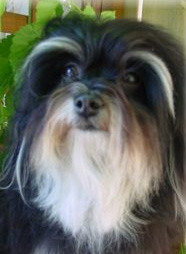Havanese
|
|
| Havanese | |||||||||||||||||||||
|---|---|---|---|---|---|---|---|---|---|---|---|---|---|---|---|---|---|---|---|---|---|
| Alternative names | |||||||||||||||||||||
| |||||||||||||||||||||
| Country of origin | |||||||||||||||||||||
| Cuba | |||||||||||||||||||||
| Classification | |||||||||||||||||||||
|
The Havanese is a member of the Bichon family of dogs, which also includes the Bichon Frise, the Bichon Bolognese, Maltese, Coton De Tulear, Tsvetnaya Bolonka, Franzuskaya Bolonka and possibly the L?en breeds. These dogs were developed from the now extinct Mediterranean Bichon Tenerife, which was introduced to the Canary Islands by the Spanish and later to other islands and colonies of Spain by sailors.
| Contents |
Appearance
The Havanese, while a toy dog and always a companion, is also a hearty and sturdy dog for such a size, and should never give the appearance of fragility or of being overly delicate. The height range is from 8? to 11? inches (216 to 292 mm), with the ideal being between 9 and 10? inches (229 and 267 mm), measured at the withers, and is slightly less than the length from point of shoulder to point of buttocks, which should give the dog the appearance of being slightly more long than tall. A unique aspect of the breed is the topline, which rises slightly from withers to rump, and the gait, which is flashy but not too reaching, and gives the Havanese a spritely, agile appearance on the move.
The expression of the face, with its almond eyes, is one of mischievousness rather than being cute, like the Bolognese, and the ears, which are medium in length and well feathered, always hang down. The tail should curve over the back at rest, and like the rest of the dog, is covered in long fur.
The key word for the Havanese is 'natural', and the breed standards note that except for slight clipping around the feet to allow for a circular foot appearance, they are to be shown unclipped; any further trimming, back-combing, or other fussing is against type and will cause a dog to be disqualified. That includes undocked tails, uncropped ears, and even a standard that forbids the use of topknots and bows in presentation. The AKC standard notes "his character is essentially playful rather than decorative" and the Havanese, when shown, should reflect that, generally looking like a toy in size only, but more at home with playing with children or doing silly tricks than being pampered and groomed on a silk pillow.
Colour
Though there is some argument on whether the original Havanese were all white or of different colours, modern Havanese are acceptable in all coat colours and patterns, with allowances made in every breed standard for their unique colourful nature. The only restrictions is that every Havanese must have a black nose and eyerims, except in all-brown dogs, where brown coloration is allowed. Popular colours include fawn, white, and black, and parti-coloured Havanese are as well regarded as solids.
Coat
Havanese, like other Bichons and related dogs like Poodles, have a coat that doesn't readily shed. Rather, it catches hair and dander internally, and needs to be regularly brushed out. Many people consider the Havanese to be nonallergenic or hypoallergenic, but they do still release dander, which can aggravate allergies. It's best to be exposed to the Havanese before deciding to choose one as a dog for a house with allergies.
Havanese have three coat types, the smooth, which is similar to the Maltese, the curly, which is not unlike a Bichon Frise coat, and the wavy, which is the preferred coat type and the type most uniquely Havanese. The hair is long, soft, and abundant, and should have no coarseness. A short coat mutation shows up occasionally in otherwise normal litters, but these are not showable Havanese and go so far against standard that even novelty breeding of them is discouraged.
Because of the tropical nature of the Havanese, the thick coat is light and designed to act as a sunshade and cooling agent for the little dog on hot days. This means, though, that the fluffy Havanese needs protection against cold winter days, in spite of the warm wooly look of their fur.
The coat can be shown naturally brushed out, or corded, a technique which turns the long coat into 'cords' of fur, and which is hard to start but easy to care for when completed.
Temperament
The Havanese has a silly, friendly temperament which is unlike many other toy dog breeds. It is at home with well behaved children and most other pets, and is rarely shy or nervous around new people. Clever and active, they will often solicit attention by performing tricks.
The Havanese is a very people oriented dog, and does not do well with long periods of separation from their family. Because of that, they are not suitable for people who work long hours or take frequent trips. They often have a habit of following their humans around the house, even to the bathroom, but do not tend to be overly possessive of their people, and do not usually suffer aggression or jealousy towards other dogs, other pets or other humans.
The Havanese's love of children stems back to the days when it was often the playmate of the small children of the households to which it belonged. Unlike most toy dogs, who are too delicate and sometimes too nervous or aggressive to tolerate the often clumsy play of children, the Havanese, with care, is a cheerful companion to even younger children, and this is no small part of its growing popularity around the world.
Health
Though the Havanese may seem to suffer from a large complement of ailments, very few Havanese from reputable breeders will have these problems, and the wide list is more a testament to highly proactive clubs and breeder organizations. Havanese clubs like the Havanese Club of America have worked hard for many years to try and search out and eradicate the health problems these dogs may suffer from. In spite of these uncommon ailments, Havanese are generally considered healthy and sturdy dogs, and live between 12–16 years.
Among these ailments are:
- Cataracts
- Patella luxation
- Hip dysplasia
- Chondrodysplasia (stunted leg growth, often resulting in bowed, dwarfed legs)
- Legg-Calve-Perthes (inheritable condition which causes femur malformation)
- Liver shunts
- Heart murmers
- Deafness
Havanese, even ones not to be bred, should go through several tests, including a one-time BAER hearing test, a CERF eye test annually, and a Patellar Palpation and Hip Evaluation. Soaping has also become a popular way for breeders to test health. It involves soaping up the dog to flatten the coat to its body and reveal the structure of the legs. Crooked, bowed or over short legs are a symptom related to many Havanese health issues, and dogs suffering from them should not be bred.
Because of the small genetic pool from which the Havanese were revived, Havanese organizations around the world are always on the lookout for new health and genetic issues that may come to the fore in this otherwise wonderful and healthy breed.
History
The Havanese itself developed uniquely in Cuba, either as the result of said Spanish sailors, or as is often believed by native Cubans, as gifts from Italian traders to open the doors of wealthy houses to their goods. The "Little Dog from Havana" even traveled back to Europe where it found brief favour in the late 19th century as a circus and trick dog and a court companion.
As part of the Cuban Revolution, many trappings of aristocracy were culled, including the pretty but useless fluffy family dogs of the wealthy land owners of Cuba! Even though many upper class Cubans fled to the United States, few were able to bring their dogs, nor did they have the inclination to breed them. Indeed, when Americans became interested in this rare and charming dog in the 1970s, the gene pool available in the US was only 11 animals.
With dedicated breeding, as well as the acquisition of some new dogs of type internationally, the Havanese has made a huge comeback, with recognition by many major kennel clubs and one of the fastest growing registration of new dogs in the AKC (+42%)in 2004. They have also suffered from a certain level of trendiness due to rarity, good temperament, and publicity by such famous owners as Barbara Walters.
Havanese at work
Because of the cheerful and readily trained nature of the Havanese, they are increasingly a dog utilized for a variety of jobs, especially those involving the public. Havanese have been utilized for:
- Therapy dogs
- Service dogs, such as aid dogs for those in wheelchairs and hearing-ear dogs
- Performing dogs
- Mold and termite detection
- Tracking
Havanese also compete in a variety of dog sports, such as
Care
Havanese have several specific considerations for their care that a prospective owner should keep in mind.
The Havanese has difficulty in housebreaking and can take a year or longer to consistently train. This is due to a smaller bladder than many other dog breeds. Crate training or litter box training are two options to help aid in this difficulty.
The Havanese has a profuse coat that requires daily grooming. If one does not intend to show their dog, it can be trimmed shorter so as to require less brushing.
The Havanese, with their drop ears, need to have their ears cleaned to help prevent ear infections.
Though they are not a dog that requires long walks, Havanese are active and require at least a large, well-enclosed yard to run around in a few times a day. They will also use up energy tearing around and getting underfoot.
The Havanese is not a naturally yappy dog, but may alert its owners to approaching people. Usually acknowledging that you have heard their alert is enough to make them cease.
Miscellaneous
Buyer beware
The Havanese is an expensive and rare dog, and the cost of getting a dog from a breeder who takes the time to put them through the right health tests can drive the price to $2000 or more. Beware of anyone who is selling a Havanese through a pet store. There is a lot of time and money invested into a healthy puppy, and a responsible breeder should want to meet you, often a few times, before selling you a puppy.
Many people sadly use the Havanese's rarity to sell them for a fast profit. Increasingly, some people will attempt to pass off a crossbred 'poodog' as the more desirable Havanese. If you must look for an inexpensive dog, try a Havanese rescue group (http://www.rescuedhavanese.org/) first.
Dog Pictures and Clipart
- Pictures of Dogs (http://classroomclipart.com/cgi-bin/kids/imageFolio.cgi?direct=Animals/Dogs)
- Dog Clipart (http://classroomclipart.com/cgi-bin/kids/imageFolio.cgi?direct=Clipart/Animals/Dog_Clipart)
Clipart and Animal Pictures
- Clipart (https://classroomclipart.com/image/category/clipart.htm)
- Animal Clipart (https://classroomclipart.com/image/category/animal-clipart.htm)
- Animal Animated Clipart (https://classroomclipart.com/clipart/Animations/Animals.htm)
- Pictures of Animals (https://classroomclipart.com/image/category/animal-photos.htm)
- Amphibian Clip Art, Pictures and Photogaphs (https://classroomclipart.com/image/category/amphibian-clipart.htm)
- Farm Animal Clip Art, Pictures and Photographs (https://classroomclipart.com/image/category/farm-animal-clipart.htm)
- Mammal Clip Art, Pictures and Photographs (https://classroomclipart.com/image/category/mammal-clipart.htm)
- Marine Animal Clip Art, Pictures and Photographs (https://classroomclipart.com/image/category/marine-life-clipart.htm)
- Reptile Clip Art, Pictures and Photographs (https://classroomclipart.com/image/category/reptile-clipart.htm)
- Spider Clip Art, Pictures and Photographs (https://classroomclipart.com/image/category/spider-clipart.htm)



